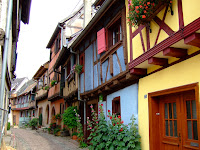

We awoke to the familiar sound of thunder and set a world record for dismantling a tent and getting it into the car, just as the rain began to make its way through the tree cover.
Our rapidly changing itinerary had rather confused us and, as it transpired, we should not have chosen Jumieges as a campsite at all,

we should have left Rouen in a totally different direction.
Nevertheless, we set off for Dieppe, as it was sort-of on our way to Calais. It was on this leg of the journey that we read other information that indicated the Somme battlefields were not where they were indicated on our map and Dieppe was not an appropriate waypoint. After a very cursory sweep through Dieppe we set off for Thiepval and ultimately traced a huge Z across France between Jumieges and Calais.

The first memorial we came across was one commemorating the Newfoundlanders and was a preserved piece of the battlefield with trenches and so forth. A foresighted Officer had purchased the land from the farmer to preserve it, just as it was. It is now a Canadian park. Clearly, over time the contours of the trenches and foxholes had softened but the effect was still incredibly sobering.

Over one million men lost their lives in this four and a half month battle in 1916 and there are cemeteries and memorials dotted across the landscape.

We stopped at the Ulster Tower – the Irish Memorial, the Connaught Cemetery and then at the main memorial for the area at Thiepval. It was there that we got accurate instructions for finding the NZ memorial, out in the middle of a field. Our last stop was the Caterpillar Valley Cemetery where, among the other Commonwealth dead, New Zealanders soldiers are buried and the names of the 1205 Kiwis whose graves are unknown are inscribed.
The Kiwis arrived in the Somme from Anzac Cove in the Dardanelles and moved on to Flanders in 1917. One cannot but leave a place like this humbled at the dedication and sacrifice of these brave men: Dardanelles, Somme, Flanders - names that will forever ring down through history.

It was time for the final sprint stage to Calais, so we left the byways and back-roads of France and paid our toll for the privilege of ticking of the final kilometres at 130 per hour.
 We started the day at Foxton Locks, where we did a 5 mile walk, based around the locks and canal. It's a very picturesque spot, where Victorian engineers came up with a clever lift to raise wide boats up to a higher level. The narrow boats had to negotiate a flight of ten back-to-back locks.
We started the day at Foxton Locks, where we did a 5 mile walk, based around the locks and canal. It's a very picturesque spot, where Victorian engineers came up with a clever lift to raise wide boats up to a higher level. The narrow boats had to negotiate a flight of ten back-to-back locks.  With such an arrangement there is no scope for passing so, once started, a boat had to ascend or descend all 10 before another boat could use the flight in the other direction.
With such an arrangement there is no scope for passing so, once started, a boat had to ascend or descend all 10 before another boat could use the flight in the other direction. Kelmarsh Hall was open for teas and visits to the garden. We enjoyed the tranquil setting.
Kelmarsh Hall was open for teas and visits to the garden. We enjoyed the tranquil setting.
































.JPG)








